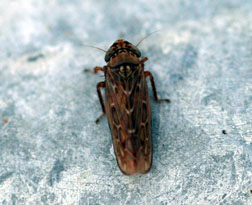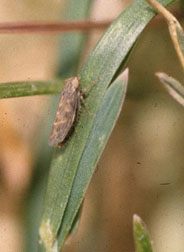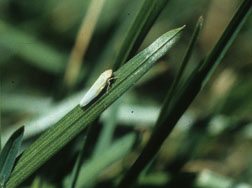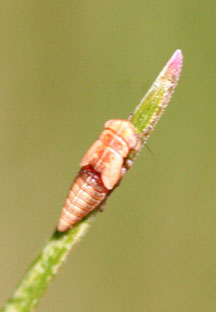by W. Cranshaw* (12/12)
Quick Facts…
- Leafhoppers are common insects of lawn that often go unnoticed.
- Leafhoppers damage is often insignificant.

Figure 1. Leafhopper. |
Leafhoppers can be common insects of lawns. They are small insects, typically less than 1/6-inch and are slightly wedge-shaped. Their color is variable but many of the more common turfgrass species are generally light colored or brown. Normally leafhoppers are not noticed, unless one looks very closely at the grass blades. However, the winged adults may be seen when one walks across a lawn or mows. These activities may disturb the insects, causing them to fly, although they usually land only a few feet away. Immature stages can jump short distances but are incapable of flying.
All stages of leafhoppers develop by sucking the sap from plants. Rarely are there any visible effects from leafhopper feeding on leaves, and damage is insignificant. At most, feeding may result in small whitish spots on the leaf.
Several species of leafhoppers can be present in a lawn. They are a mixture of species that winter locally in lawns and those that migrate annually from more southern areas of the United States.1 All of those that develop on turfgrasses insert their eggs into the leaf blade. The young nymphs hatch in a few days. Nymphs generally resemble the adults in body form but are wingless. They become full-grown with weeks.

Figure 2. Leafhopper on bluegrass. |

Figure 3. Sharpshooter leafhopper. |

Figure 4. Leafhoper nymph. |
Control
Leafhoppers cause very little, if any, injury to lawns but do attract attention and may be considered a minor nuisance. Control of leafhoppers can not be justified in regards to concern about the health of the lawn. However, if desired, leafhoppers can easily be controlled by many insecticides that can be applied as sprays to lawns (e.g., lambdacyhalothrin, deltamethrin, permethrin). Turfgrass insecticides that move systemically in the plant (e.g., imidacloprid, clothianidin) will also control leafhoppers.
1Among the leafhoppers recorded from Colorado turfgrass are Balclutha neglecta, Dikraneura carneola, Endria inimica, Exitianus exitiosus, Psammotettix lividellus, and Macrosteles spp.
*W. Cranshaw Colorado State University Extension entomology specialist, and professor, bioagricultural sciences and pest management. 1/08. Revised 12/12.
Colorado State University, U.S. Department of Agriculture, and Colorado counties cooperating. CSU Extension programs are available to all without discrimination. No endorsement of products mentioned is intended nor is criticism implied of products not mentioned.
Go to top of this page.





